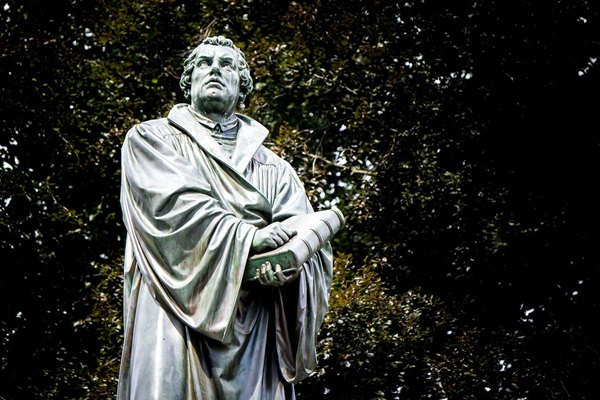Many Protestants observe October 31 as Reformation Day, commemorating the date in 1517 when Martin Luther published his Ninety-Five Theses, initiating the Protestant Reformation. While Protestants everywhere owe a great debt to Luther, he shares a unique connection to Methodism and its founder John Wesley, in particular.
Things they had in common
Luther and Wesley were a lot alike in a number of ways. Both were ordained clergy, lived deeply pious lives, wrote and published theology extensively and preached the importance of God’s grace above all else. Both were also reformers in their own time who set out initially not to start new Christian sects/denominations, but reform the Churches they were up brought in, Roman Catholicism for Luther, and Anglicanism for Wesley.
Both men endured traumatic experiences early in life that contributed to their sense of calling. Luther was nearly struck by lightning while traveling as a young man, promising to become a monk after he was spared. Wesley almost died in a house fire at the age of five. After he was pulled out from a window by a neighbor on a ladder, Wesley’s mother Susanna would refer to her son as “a brand plucked out of the fire” for some special purpose by God.
Both men also experienced prolonged periods of anxiety early in their ministries, characterized by fear that they were unworthy of God’s love and would be denied salvation. Both came out of these after deeply emotional experiences in which they felt an assurance that God loved them in spite of their many shortcomings.
Luther at Aldersgate
The connection between Luther and Wesley is most visible in Wesley’s “Aldersgate Experience”. On May 24, 1738, Wesley attended a Moravian society meeting on Aldersgate Street in London. At the time he had been feeling extremely anxious and depressed.
During the evening Wesley heard a reading from Luther’s own preface to Paul’s Epistle to the Romans. This epistle had a profound impact on Luther as well, who declared it “the most important piece in the New Testament. It is purest Gospel. It is well worth a Christian's while not only to memorize it word for word but also to occupy himself with it daily, as though it were the daily bread of the soul.”[1] Luther’s own doctrine of sola fides (faith alone) that inspired the Reformation came from his reading of Romans.
While listening to Luther’s commentary on this vital epistle, Wesley claimed to have felt his “heart strangely warmed” experiencing a joy and assurance that brought him out of his depression.
“About a quarter before nine, while he was describing the change which God works in the heart through faith in Christ, I felt my heart strangely warmed. I felt I did trust in Christ, Christ alone, for salvation; and an assurance was given me that He had taken away my sins, even mine, and saved me from the law of sin and death.” John Wesley May 24, 1738.[2]
Other connections to Luther
Wesley references Luther in a number of his sermons. In “Salvation by Faith” he praises the German reformer for recovering the Biblical doctrine of justification he believed had become forgotten prior to the Reformation.[3] In “The Wisdom of God’s Counsels”, Wesley describes Luther as a special instrument “chosen of God” to recover the lost wisdom of Gospel.[4]
Wesley and the Methodists also formed connections and partnerships with modern-day followers of Luther. Wesley met German Moravians during his time in Georgia and briefly visited their communities in Saxony. He was impressed by the sense of assurance the Moravians exhibited and the way they organized themselves into small groups, which he adapted into his own Methodist groups, but he gradually broke away from them over disagreements on the nature of sanctification.[5]
German Lutherans began arriving in North America in large numbers around the same time Methodist societies began forming there. A number of them became active in these Methodist groups, including Jacob Albright, the founder of the Evangelical Association (one of the predecessor denominations to The UMC).
In 2009, The United Methodist Church entered full communion with the largest Lutheran denomination in North America, the Evangelical Lutheran Church of America (ECLA). These two denominations share a lot in common, just like the men whose teachings they follow. Both have bishops, both acknowledge the baptism and communion as sacraments, both ordain men and women alike and both are the results of 20th Century mergers of different denominations coming together.
Honor the legacy
This Reformation Day, we encourage United Methodist everywhere to honor the legacy of the Protestant Reformation that began with Martin Luther and celebrate the connections between Luther and Wesley and the common ground that have brought their modern-day followers closer together in recent years.
This content was published on October 18, 2024. Philip J. Brooks is a writer and content developer at United Methodist Communications. Contact him by email.
[1] Heitzenrater, Richard P. Wesley and the People Called Methodists. Nashville: Abingdon Press, 1995.
[2] Idem.
[3] Wesley John. “Salvation by Faith.”
[4] Wesley, John. “The Wisdom of Gods Counsels.”
[5] Heitzenrater, Richard P. Wesley and the People Called Methodists. Nashville: Abingdon Press, 1995.





